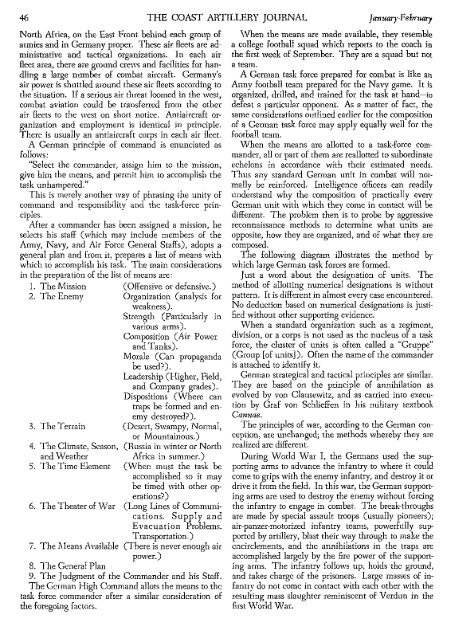January-February - Air Defense Artillery
January-February - Air Defense Artillery
January-February - Air Defense Artillery
You also want an ePaper? Increase the reach of your titles
YUMPU automatically turns print PDFs into web optimized ePapers that Google loves.
46 THE COAST ARTILLERY JOURNAL <strong>January</strong>-<strong>February</strong><br />
North Africa, on the East Front behind each group of<br />
armies and in Germany proper. These air Beets are administrative<br />
and tactical organizations. In each air<br />
Beet area, there are ground crews and facilities for handling<br />
a large number of combat aircraft. Germany's<br />
air power is shuttled around these air fleets according to<br />
the situation. If a serious air threat loomed in the west,<br />
combat aviation could be transferred from the other<br />
air Beets to the west on short notice. Antiaircraft organization<br />
and employment is identical in principle.<br />
There is usually an antiaircraft corps in each air fleet.<br />
A German principle of command is enunciated as<br />
follows:<br />
"Select the commander, assign him to the mission,<br />
give him the means, and permit him to accomplish the<br />
task unhampered."<br />
This is merely another way of phrasing the unity of<br />
command and responsibility and the task-force principles.<br />
After a commander has been assigned a mission, he<br />
selects his staff (which may include members of the<br />
Army, Navy, and <strong>Air</strong> Force General Staffs), adopts a<br />
general plan and from it, prepares a list of means with<br />
which to accomplish his task. The main considerations<br />
in the preparation of the list of means are:<br />
1. The Mission (Offensive or defensive.)<br />
2. The Enemy Organization (analysis for<br />
weakness).<br />
Strength (Particularly in<br />
various arms).<br />
Composition (<strong>Air</strong> Power<br />
and Tanks).<br />
Morale (Can propaganda<br />
be used?).<br />
Leadership (Higher, Field,<br />
and Company grades).<br />
Dispositions (Where can<br />
traps be formed and en-<br />
3. The Terrain<br />
4. The Climate, Season,<br />
and \i\Teather<br />
5. The Time Element<br />
emy destroyed?).<br />
(Desert, Swampy, Normal,<br />
or Mountainous.)<br />
(Russia in winter or North<br />
Africa in summer.)<br />
(When must the task be<br />
accomplished so it may<br />
be timed \vith other operations?)<br />
6. The Theater of \iVar (Long Lines of Communications.<br />
Supply and<br />
Evacuation Problems.<br />
Transportation. )<br />
7. The Means Available (There is never enough air<br />
power.)<br />
8. The General Plan<br />
9. The Judgment of the Commander and his Staff.<br />
The German High Command allots the means to the<br />
task force commander after a similar consideration of<br />
the foregoing factors.<br />
\\Then the means are made available, thev resemble<br />
a college football squad which reports to th~ coach in<br />
the first week of September. They are a squad but not<br />
a team.<br />
A German task force prepared for combat is like an<br />
Army football team prepared for the Navy game. It is<br />
organized, drilled, and trained for the task at hand-to<br />
defeat a particular opponent. As a matter of fact, the<br />
same considerations outlined earlier for the composition<br />
of a German task force may apply equally well for the<br />
football team.<br />
When the means are allotted to a task-force commander,<br />
all or part of them are reallotted to subordinate<br />
echelons in accordance with their estimated needs.<br />
Thus any standard German unit in combat will normally<br />
be reinforced. Intelligence officers can readily<br />
understand why the composition of practically every<br />
German unit with which they come in contact will be<br />
different. The problem then is to probe by aggressive<br />
reconnaissance methods to determine what units are<br />
opposite, how they are organized, and of what they are<br />
composed.<br />
The following diagram illustrates the method by<br />
which large German task forces are formed.<br />
Just a word about the designation of units. The<br />
method of allotting numerical designations is without<br />
pattern. It is different in almost every case encountered.<br />
No deduction based on numerical designations is justified<br />
without other supporting evidence.<br />
When a standard organization such as a regiment,<br />
division, or a corps is not used as the nucleus of a task<br />
force, the cluster of units is often called a "Gruppe"<br />
(Group [of units]). Often the name of the commander<br />
is attached to identify it.<br />
German strategical and tactical principles are similar.<br />
They are based on the principle of annihilation as<br />
evolved by von Clausewitz, and as carried into execution<br />
by Graf von Schlieffen in his military textbook<br />
Cannae.<br />
The principles of war, according to the German conception,<br />
are unchanged; the methods whereby they are<br />
realized are different.<br />
During World War I, the Germans used the supporting<br />
arms to advance the infantry to where it could<br />
corne to grips with the enemy infantry, and destroy it or<br />
drive it from the field. In this war, the German supporting<br />
arms are used to destroy the enemy without forcing<br />
the infantry to engage in combat. The break-throughs<br />
are made by special assault troops (usually pioneers);<br />
air-panzer-motorized infantry teams, powerfully supported<br />
by artillery, blast their way through to make the<br />
encirclements, and the annihilations in the traps are<br />
accomplished largely by the fire power of the supporting<br />
arms. The infantry follows up, holds the ground,<br />
and takes charge of the prisoners. Large masses of infantrv<br />
do not corne in contact with each other with the<br />
resulting mass slaughter reminiscent of Verdun in the<br />
first vVorld War.
















